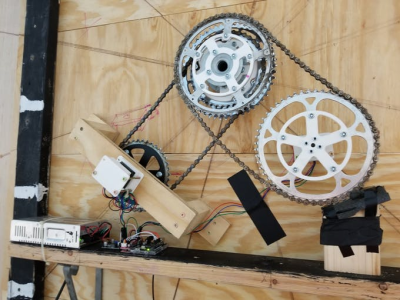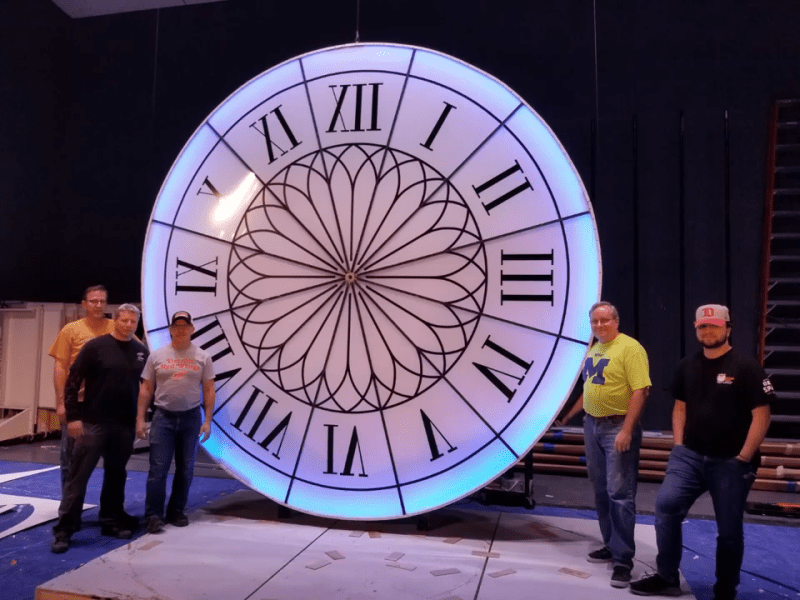When [tnjyoung] was asked to build a huge lighted clock for a high school theater’s production of Cinderella with only two weeks before opening night, he probably wished for a fairy godmother of his own to show up and do it for him. But he and his team pulled it off, and it looks amazing. That medallion in the middle? It was laid out painstakingly by hand, using electrical tape.
 This thing is 12 feet wide and weighs more than 500 pounds. Even so, it isn’t a permanent set piece, so it has to move up and down throughout the show on airplane cables. Now for the minutiae: there’s an Arduino Uno with built-in Wi-Fi that receives UDP commands from a phone to raise and lower the clock at the appropriate times. The ‘duino is also controlling two stepper motors, one for the hour hand and one for the minute hand.
This thing is 12 feet wide and weighs more than 500 pounds. Even so, it isn’t a permanent set piece, so it has to move up and down throughout the show on airplane cables. Now for the minutiae: there’s an Arduino Uno with built-in Wi-Fi that receives UDP commands from a phone to raise and lower the clock at the appropriate times. The ‘duino is also controlling two stepper motors, one for the hour hand and one for the minute hand.
Time is almost a minor character in the story of Cinderella, since she has to get back by midnight. Because of this, [tnjyoung] programmed a dozen or so time cues that move the steppers at various speeds to achieve different effects, like time flying by as she dances the night away with the Prince. Hour you still just sitting there? Sweep past the break to watch the build process fly by in a matter of minutes.
Got all the time in the world? Make a clock out of clocks. Clocks all the way down.
















The only thing missing is a glass shoe. Excellent work… only 2 weeks!?? amazing!
“Hour you still just sitting there?”
*GROAN*
…nice one!
the V, in “IV” seems flipped.
Also clocks/watches generally use IIII for 4, to balance the heavy VIII 8
The “X” is flipped as well. The strokes going from the upper left to the bottom right (reading direction) should be thick, the strokes from the bottom left to the upper right should be thin.
Nice work with the electrical tape. I hope no one in the production is ever underneath a 500 pound prop that goes up and down under control of a $9 part that is controlled over WiFi though.
There’s a cry wolf problem with that now. Stuff that would have been considered suitable, in strength and reliability for handling live loads or safety critical stuff 20 years ago has the same “not for live loads or where human life at stake” warning, the same as the really crappy stuff. So you’ve gotta pick your way through that mess or spend $20,000 on a $200 problem every time.
Also, the article is wrong. The Arduino has nothing to do with lifting the clock. Its controlling the steppers that drive the hands.
This will almost certainly be manually lifted in & out using the flying system in the theatre. Any decent theatre will have a full counter-weighted flying system for exactly this purpose.
You wanna stand under something that is being held over your head by a no name Chinese SSR, or something like an Opto 22? There is also the issue of programming and being controlled by WiFi. I worked in a lab where we had heavy parts that needed to be lifted overhead on a regular basis, and most of the equipment we used had the not for overhead lifting. I took that literally and made sure whenever something was lifted, no one was under it until we had it up and had safety chains on it to make very sure it would stay that way.
It’s not a “cry wolf” problem at all and you downplaying the danger is abhorrent.
Winch failures are one of the top causes of injury/death for actors, aerial and circus performers. They’re almost always caused by using winches not designed for human loads. Typically the winch brake fails, but cable failures due to improper winding mechanisms on the drum happen as well.
They’ve also resulted in some spectacular failures. Several scoreboards in major ice hockey and basketball arenas have come crashing down and so have a number of video walls at festivals and concerts, thankfully only during setup. Reddit’s catastrophic failure subreddit has documented many of them. Hell, there’s been at least one winch failure that resulted in an entire massive industrial gas turbine assembly coming crashing down at a power plant.
Unless they have clearly demarked where the set piece would fall *and* provided a safety buffer on top of that, this is a disaster waiting to happen. And it could be something as simple as the winch getting repeatedly actuated in a short time period, causing the brake to overheat.
Yikes, this writer missed some big stuff… As an industry professional, I almost had a heart attack reading that the (theatrical) automation for this was controlled by an Arduino and UDP packets over wifi…. That would be a big YIKES.
Luckily, no, looks like its flown like a regular set piece from aircraft (not airplane!) cable (aka wire rope). Even a manually operated counterweight fly system is the most dangerous piece of a equipment in a theater, but this at least is just like a regular flat. I get that real rigging and automation stuff gets expensive quick, but there’s a real safety reason. The companies that manufacture this stuff are insured and bonded, so when 5 high schoolers get squashed because an E-Stop didn’t work, there’s a chain of liability, and someone who can answer to their families.
It looks like the clock is controlled via the Arduino and WiFi, which is much better use of that technology.
I’d like to know which version of Cinderella they did. Was it one of the classics, the Rodgers and Hammerstein 1957 TV version, the stage show based on it, the 1965 TV version sorta based on the previous TV and stage show, the 1997 TV version drifting farther off the 1957 version, any of the other various stage productions through the years mishing and mashing bits and pieces from the three TV productions and original R&H stage show?
Or was it that execrable 2013 Rodgers and
HammersteinBeane version with added characters for its SJW political subplot and 2+ hour length? When schools pay for a production license for *that one* they’re limited on how many ticketed performances they can put on and absolutely no photography or video or audio recording of the performance is allowed.There are some public domain Cinderella scripts, or one could be written based directly on the original story.